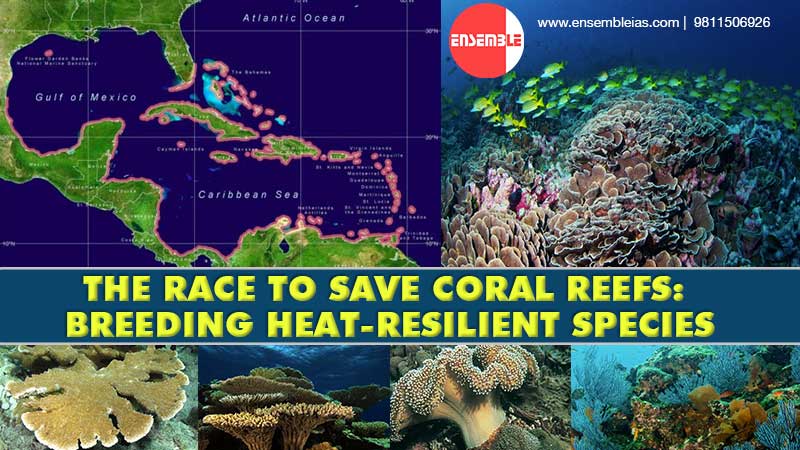Collaborative Efforts to Protect Coral Reefs from Climate Change. The Urgent Need to Protect Undiscovered Species.
Learn about the collaborative efforts of organizations like NOAA, Australian Institute of Marine Science, and universities to breed heat-resilient coral species in order to protect these vital ecosystems from the impacts of global warming.
Mass Coral Bleaching
See on map,
Rise in global temperature has exposed the coral reefs to unprecedented heat stress around the world, northern and southern Atlantic Ocean witnessing the worst of it. The two oceans experienced record-breaking heat stress level in the summer of 23. Elkhorn and Stagehorn, a key reef-building species, found in the southern region of North America faced severe mortality rate.

Approximate range of general distribution of the species Staghorn coral (A. cervicornis) and
Elkhorn coral (A. palmata) throughout the wider Caribbean, (source: (Acropora Biological Review Team [ABRT], 2005).
Intensity and duration of heat stress elevates the bleaching response of corals. In Florida, the heat stress reached two to three times higher than before which persisted for longer period. Time and dosage response to heat stress is high for coral species. Corals tend to rebuild at a faster rate than they are eroded by factors like storms and biological processes but in a scenario of widespread coral mortality, reef’s erosion rate exceeds growth rate.
To buy our online courses: Click Here
Coral reefs have the ability to recover from a bleaching event in 6-7 years but researcher fear that it may be not enough for them to return to their full health considering the current mass bleaching event. The growth rate has fallen for two to four years but larvae production (reproductive output) of coral has declined for up to five years. Bleached corals are more susceptible to diseases and remains in a chronic state of stress which diminishes their chances of full recovery.
Coral reefs in Galapagos were discovered in 1970’s but due to El Nino effect in 1982-83, 95 to 99 percent of the coral reef died and today, due to no growing skeleton, all of coral reefs have died in the region. In some parts of Great Barrier Reef, 90-95 percent of coral reefs are severely affected with bleaching and under great threat of extinction.
Over 25 percent of marine eco-system is associated with coral reefs. Morality of coral would affect the habitat of marine life like that of plants and fishes. Today, in Galapagos, one will see barren white ocean floor, completely different from what it was in 1970s.
Efforts are taken globally to restore the coral reefs and limit the bleaching event. US National Oceanic and Atmospheric Administration (NOAA), Australian Institute of Marine Science and University of Hawaii and University of Maima are engaged in efforts to accelerate evolution of corals and making them more heat resilient. Their ability to breed in higher temperature can evolve them into more heat-tolerable species. For long lasting solution, climate models need to change to limit the global warming. If the current trend continues, we might not only lose coral reefs but also millions of undiscovered species living under their ecosystem.
By Amey Sharma
Also Read:UPSC Mains | Geography Optional Paper-1| Answer Discussion | CORAL BLEACHING | K. Siddhartha Sir




